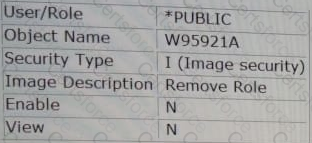Which statement is false concerning the installation of the JD Edwards EnterpriseOne Deployment server?
Before Tools 9.2.1.0, which three object types had components stored on the deployment server’s patch code check-In location?
Which two directories are automatically backed up in a. jar file while upgrading the Deployment Server Tools Release by using Server Manager?
What does the following security record found in Security Workbench (P00950) enforce?

A JDE user has two roles (ROLE1 and ROLE2) assigned. The role sequence and security for the two roles are defined as follows:

What happens when the user logs in to JDE as *All and tries to access the Address Book (P01012) application from fastpath?
When attempting to sing in to a workstation, you receive a database password entry from requesting credentials to access the system database. You validate that you credentials are working correctly by signing to EnterpriseOne on another workstation and through the web console.
Identify three causes of this issue.
Which of the following JDE> INI settings is responsible for the automatic restart of the scheduler at the time of EnterpriseOne service Restart?
You are creating a custom in Change Assistant for fix-current Electronic software Updates (ESUs) for your system. The last time you have installed fix-current ESUs was three months ago. Which three criteria options need to be set in Change Assistant ?
Which package Assembly from must you use to add registry setting to a package?
Identify the correct list of requirements when enabling Long Passwords in EnterpriseOne.